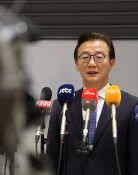Gov’t needs to focus on basic measures to boost fertility
Gov’t needs to focus on basic measures to boost fertility
Posted April. 26, 2024 08:05,
Updated April. 26, 2024 08:05
The number of babies born in February this year reached a record low of 19,362. Birth rates typically peak in January and February, as it's believed that children born early in the year have an easier time adjusting to elementary school. However, the number of births fell below 20,000, making it less distinguishable from December, which is traditionally the least fertile month. At this rate, the fertility rate is expected to decline to 0.6 this year.
In the wake of last year's alarming fertility statistics, the government is reshuffling ministers and considering extraordinary measures, as previous governments have done. The ruling party wants to create a vice-prime ministerial-level population ministry to boost the momentum of birthrate policies. The Dong-A Ilbo has commenced the second phase of its long-term plan, 'Birthrate, Back to 1.0,' conducting surveys and in-depth interviews with young Koreans in their 20s and 30s. It found that the reasons behind their reluctance to start families are widely recognized. Even for working couples with stable jobs, the burden of housing and childcare expenses is overwhelming, and they find it challenging to afford raising a child while working due to the rigid work system or the feeling that they are walking on eggshells at work when they take parental leave. These are issues that have been repeatedly raised over the past 18 years since the implementation of the low birthrate policy in 2006 when the fertility rate was 1.13. Many young people have expressed that they would consider having children if these obstacles were removed.
Extraordinary measures are typically taken as a last resort. However, government spending on family-related expenditures, such as childcare allowances and childcare support—essential budgets for boosting the birthrate—is only 1.6 percent of gross domestic product (GDP), well below the Organization for Economic Cooperation and Development (OECD) average of 2.2 percent. This indicates that the government spends approximately 10 trillion won less per year on 'basic measures' alone. Over the past 18 years, the government has allocated 380 trillion won to birth-boosting measures, but most of this expenditure has been directed towards fertility-related projects. Ministries and departments have attached the 'low birthrate' label to policies unrelated to fertility in order to secure larger budgets easily and avoid criticism for neglecting the issue. It's difficult to imagine the birth rate increasing if funds are misallocated and efforts to boost fertility are superficial.
Experts consulted by The Dong-A Ilbo pointed out the urgent need to reallocate the budget aimed at boosting fertility. This includes increasing child allowances, promoting work-family balance, supporting education expenses, and offering childbirth and maternity support. The fertility-enhancing effects of each policy are now quantifiable. Rather than searching for new and innovative measures, we should establish realistic fertility targets and concentrate our limited budgets on proven policies. That way, the question of ‘where did all that money used to boost fertility go?’ will never be asked again.



![싱크대에 끓는 물 부어 청소? 수리비 폭탄 맞는다 [알쓸톡]](https://dimg.donga.com/c/138/175/90/1/wps/NEWS/IMAGE/2025/12/10/132935996.3.jpg)

![“양말 버릴 필요 없다”..수명 늘리는 가성비 甲 루틴 3단계 [알쓸톡]](https://dimg.donga.com/c/138/175/90/1/wps/NEWS/IMAGE/2025/12/09/132929830.3.jpg)

